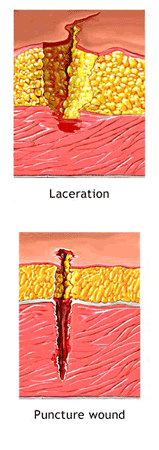First Aid – Cuts & Scrapes
Breaks in the skin range from pin punctures or minor scratches to extensive cuts, tears and gashes. In First Aid, open wounds are divided into six categories: abrasions, amputations, avulsions, incisions, lacerations, and punctures.

Abrasions are caused by rubbing or scraping with the wound generally shallow and a portion of the skin damaged, leaving a raw surface with minor bleeding.
Amputations involve extremities such as fingers, toes, hands, feet, or entire limbs severed completely from the victim’s body. Depending on the type of amputation, bleeding may be excessive or very restricted.
Avulsions are injuries that tear a whole piece of skin and tissue from the body, usually as a result of violent or forcible separation. Although these injuries may often be successfully repaired if treated quickly, there is great danger of infection and bleeding.
Incisions are produced by a sharp cutting edge such as a knife or glass. If an incision is deep, major blood vessels and nerves my be severed making it difficult to control blood flow.
Lacerations are similar to incisions but have rough or jagged edges with the flesh torn or cut with a blunt edge.
Puncture wounds are produced by pointed objects being forced through the skin. Although the small number of blood vessels damaged sometimes prevents excessive bleeding, there is danger of infection due to this poor drainage.
General First Aid for bleeding
The main objectives in administering first aid to a bleeding victim are to stop blood flow and to prevent germs from entering the wound.
- expose the wound by carefully cutting away at clothing around it
- carefully remove any loose foreign body around the wound with clean material, always wiping away from the wound
- if an object has impaled the victim, do not attempt to remove it as this may cause excessive bleeding and other serious injury
- dress the wound with sterile gauze or similar material, covering the wound completely
- unless otherwise specified, apply direct pressure to the wound to stem blood flow
- keep the victim still and calm
- if necessary, treat the victim for shock
- seek medical attention
The first and possibly most important step when treating minor cuts and scrapes is to thoroughly clean the wound with mild anti-bacterial soap and water. You can use sterilized tweezers to remove any debris that remains embedded in the wound after rinsing. This will reduce the risk of an infection and possible complications. If the debris is abundant or can’t be removed for some other reason, a trip to the emergency room will be necessary.
Water may induce bleeding by thinning the blood. If while rinsing the wound you notice increased blood flow, use gauze or a clean cloth to apply gentle, continuous pressure until the blood clots.
Although hydrogen peroxide is commonly used as a disinfectant for minor cuts and scrapes, it is actually not very effective and may even delay the healing process by irritating a person’s living cells. You can use hydrogen peroxide but apply it around the open wound, not directly to it. An antibiotic ointment such as Neosporin is a better alternative – it will keep the wound from getting infected and speed up the healing process.
Dress the wound with a bandage or sterile gauze to keep dirt and bacteria out. Change the dressing frequently and rinse the wound as often as necessary to keep it free of dirt.
Continue to monitor the wound for several days. If the injured area turns red or puffy, or if excessive pain persists, then it may’ve become infected and will require a physician’s attention. Do not simply dismiss cuts as minor injuries as some may be quite serious if not tended to by a professional. If the wound is very deep or the bleeding is profuse, it may require stitches in order to heal properly.